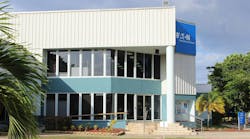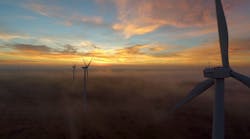If you have sailed even the smallest of sailboats, you probably have spent at least a little time thinking how cool it is to harness the power of the wind. Perhaps you have had a bad case of “two-footitis, ” where you rationalize how buying that new sailboat just two feet longer will make you sail so much faster. If you have some interest in ancient history, you may be fascinated by the fact that the Persians in 500- 900 A.D. first developed windmills using a vertical axis system to grind grain and pump water.
More likely, you are just an electrical distributor, independent manufacturers' rep or electrical manufacturer searching for some new market opportunities in this uncertain economy. Depending on where you are in North America, you may be able put a little more wind in your sails (and sales) by selling the electrical products that wind turbines need to convert the wind into electricity. It's by no means a slam-dunk, mail-it-in no-brainer, because like any new market opportunity, the wind industry has its own share of challenges. As part of Electrical Wholesaling's continuing series on the green market, this article will provide a “Market 101” analysis of the wind industry. It will look at the good, the bad and the just-plain ugly market facts in the wind business and see how it may or may not provide new sales opportunities in for distributors, reps and manufacturers in the electrical market.
The wind business is not new business for some electrical companies
If you are a high-roller cruising I-10 on your way to Las Vegas or an NAED Conference attendee on your way to the Marriott Desert Springs in Palm Desert, Calif., you have seen the dozens of wind turbines in the Coachella Valley east of a pass in the San Jacinto Mountains. In July 2001, Electrical Wholesaling did a cover story on WECS (Wind Energy Conversion Systems) Electric Supply, a North Palm Springs distributor that specialized in servicing the Coachella Valley wind farms that harvest the wind blowing through that mountain pass. Company President Bruce Hammett and WECS have been in the wind market there for 19 years.
Independent rep Bill Devereaux, president, R/B Sales Corp., Marion, Iowa, has also enjoyed wind business for quite some time. As you can learn in “The Road to Omaha,” (page 42), Devereaux and the R/B sales team first started serving Iowa's wind farms in 1999 and are still profiting from the growth in that state's substantial wind business.
The big business in the wind industry is in the utility-scale facilities that power companies are either building or having wind specialists build for them. As a utility distributor with the right connections with power companies, Wade Patterson, president, Tri State Utility Products Inc., Marietta, Ga., says his company is supplying box pads for transformers, cable and connectors to wind farms. Another distributor who has enjoyed sales from the wind industry doesn't want to talk too much about his success in this market because he is afraid the bigger distributors in his market area will grab his share of what has been a lucrative business.
“We're concerned about becoming more of a target,” says one California distributor who asked not to be quoted by name. “People involved in this market are reluctant because we feel like we're in the crosshairs of the big distributors right now.”
He says his company has been supplying the smaller electrical parts, primarily pipe and wire, for construction on a local wind farm, and the volume has helped his company endure the slowdown in the economy. “It makes up for the residential market, which is in the tank, and the commercial market, which is struggling,” he says.
His company got into the wind power market through an electrical contractor who has been a good customer for years. “They got into it and brought us into it. The two of us work well together, and where we go with it depends on what projects they land. Everyone's expecting it to grow over the next few years. As that happens, it gets harder for us to hold onto our portion of it.”
The products that wind farms need are pretty basic stuff
As you can see in the sidebar, “Do You Sell Any of These Products?” you may already stock many of the key electrical products needed to run wind turbines and connect them to the electrical grid. Don't even consider stocking 341-foot long rotors for giant 3 MW wind turbines, or the steel lattice necessary to construct a 200-foot tower. Leave that to the experts.
The wind industry lives and dies on government subsidies
While wind farms utilize proven technologies, the wind industry as a whole still depends on government subsidies for much of its growth. When federal tax credits and related financial incentives are in effect, the investment dollars flow into this market. But when they expire, as they did in 1999, 2001 and 2003, the wind industry suffers.
According to the American Wind Energy Association (AWEA), Washington, D.C., the income tax credit created under the Energy Policy Act of 1992 is set to expire on Dec., 31, 2008, unless Congress reinstates it. The current tax credit offers two cents/kilowatt-hour for the production of electricity from qualified wind energy facilities and other sources of renewable energy.
The credit applies to electricity produced by a qualified wind facility placed in service between Jan. 1, 1993, and Dec. 31, 2008, and applies for the first 10 years of production. The tax credit is useful only for utility-scale wind turbines, not smaller turbines used to power individual homes or businesses. While the Senate recently voted to extend this tax credit for one year, the AWEA says its status in the House of Representatives is uncertain.
AWEA Executive Director Randall Swisher said in a press release that the U.S. wind industry is installing new wind turbines at a “breakneck pace” and that during the first quarter of 2008, 1,400 megawatts (MW) (approximately $3 billion worth of new generating capacity) was installed. These new wind farms can produce enough power to serve 400,000 homes.
“But if Congress does not act quickly, this momentum could be derailed at the worst possible time for the economy, placing 76,000 jobs and over $11.5 billion in investment at risk,” Swisher said in the press release. “While 2008 is shaping up to be another great year, we could see a very different story in 2009 as uncertainty looms over investment in wind power projects and manufacturing due to continuing delays in extending the production tax credit (PTC),” Swisher added. “The PTC is the primary federal incentive for wind power, and expires at the end of the year along with incentives for other renewable electricity sources.”
It's sometimes hard to get the power from here to there
Harvesting the wind is a wonderful idea, but if you can't get the power from where it's being harvested to where it's needed by homeowners, businesses and other customers, it doesn't help anyone. Many of the best areas to harness the wind are miles from any major transmission grids. If wind energy is to contribute more than its current 1 percent to the overall U.S. energy mix, the U.S. electrical grid will require some major new construction and modifications.
According to “20% Wind Energy by 2030,” a massive research report recently published by the AWEA that examines what it would take for wind farms to produce 20 percent of all electrical power in the United States by 2030, this is one of the biggest challenges that could prevent wind energy from being a truly major power producer for the U.S. power mix.
The last word
The wind market won't be for everyone in the electrical wholesaling industry. Many areas of the United States just aren't windy enough, don't have enough available land for wind farms, or are just too darn far from the power grid to economically harvest wind power. But if you do business in the windier regions of the Midwest, Texas, California or in coastal states considering offshore wind farms, this market might be for you. These areas are already seeing lots of new utility-scale farms.
You will continue to find the occasional wind turbine almost anywhere if a homeowner or business is intent on living off the grid or supplementing their utility-grade power with green power from wind turbines, but the electricity produced from these installations will never add up to what's produced by utility-scale wind farms.
The products aren't all that different in this market niche from what you already stock and the customers' service needs are the same. Who knows? This market might just be what your business needs to catch some air in a down economy.
Do You Sell Any of These Products?
Wind turbines require lots of conventional electrical products to get tied into the electrical grid. If you haven't yet sold any of these products, you may in the near future.
- Pad-mounted transformers
- Medium-voltage power-factor correction products
- Medium-voltage cable
- Cable lugs
- Splices
- Cold-shrink rubber termination kits
- Connectors
- Motors and hydraulics
- Motor controls
- Low-voltage circuit protection equipment
- Capacitors
- Tower lighting equipment such as LED strobe beacons
- Bi-directional meters for net metering
Fun Facts About the Wind
-
What was Jimi Hendrix thinking about when he wrote the lyrics for his 1967 hit, “The Wind Cries Mary”?
A fight with his girlfriend. According to Rolling Stone magazine, after a “dish-smashing argument” with his girfriend, Hendrix was left alone in his London apartment and wrote the song, which appeared on his classic album, Are You Experienced?
-
Which state has the most potential for wind power?
North Dakota. With so much wind blowing across its lonely plains, North Dakota could generate 1,210 MW of electricity, according to the American Wind Energy Association (AWEA). That's probably why the state has “SNERT storms” in the winter — a mix of snow, dirt and fertilizer whipped up by the wind.
-
What is the tallest wind turbine in the world?
The Fuhrlander Wind Turbine in Laasow, Germany. Built in 2006, this monster is 673 feet tall, has a rotor almost 300-feet long and produces 7,000MW per year — enough power for 1,800 four-person households.








